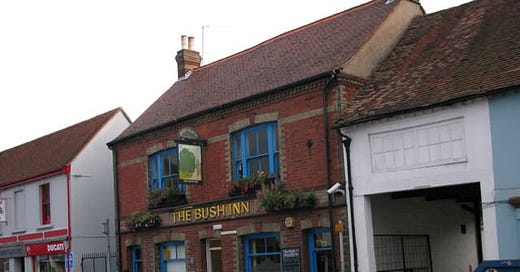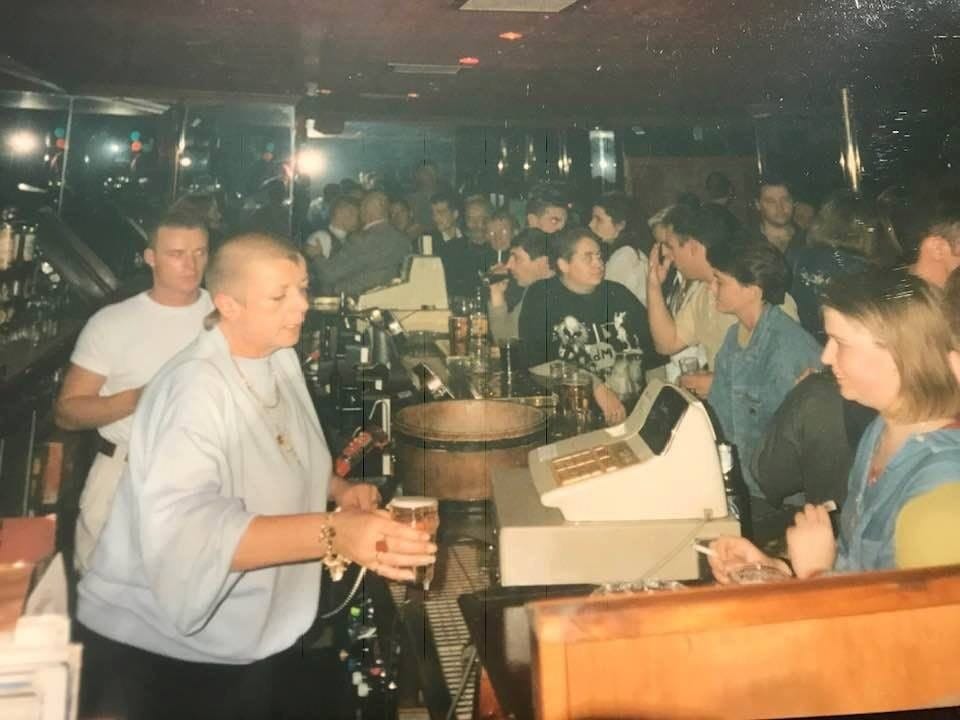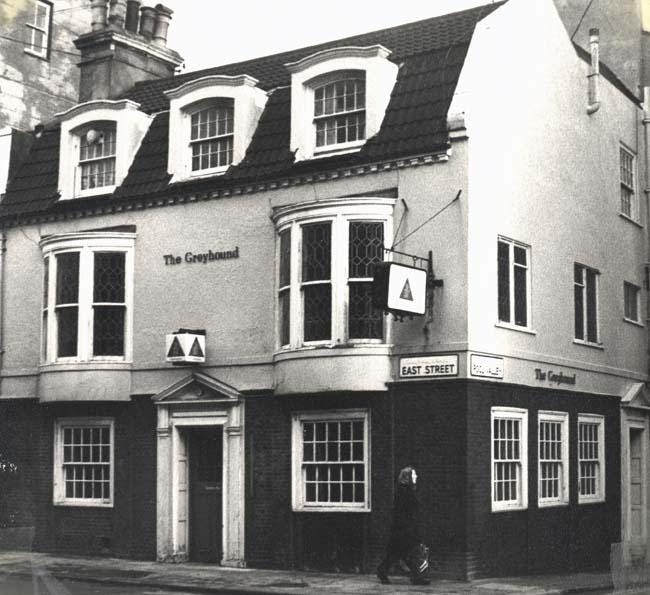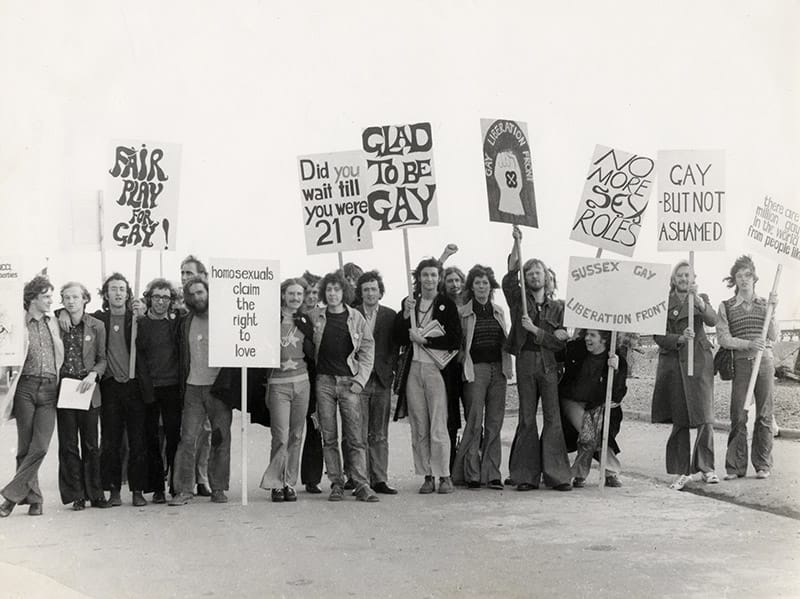The Bush, Chichester - word gets around that it's a gay pub
In the first of three parts, Alf Le Flohic, a queer historian, speaks about navigating the gay pub scene in 1980's Sussex
These articles are vital and entirely funded by me, so please donate here to continue to support similar investigations. If that link doesn’t work for you (or if you’re paying by Mastercard) then you can also use my Ko-Fi here.
I am a journalist who writes for BBC Culture, Pellicle and Vittles. I was named Beer Writer of the Year in 2023 by the British Guild of Beer Writers.
I’m offering my book, Desi Pubs, at Amazon prices. I can have it sent to you very quickly for £12.29! Message me on Bluesky for copies. There’s a review of it here.
Disclaimer: this newsletter often mentions beer and pubs. You do not have to read this if your life has been affected by substance abuse.
I want to focus the next few Substacks on the late 20th century fight for gay inclusion in pubs outside of London and particularly in the Sussex area of the UK.
For this I’ve interviewed Alf Le Flohic, a queer historian, who was born in Southampton in the mid-1960s, who will explain how he navigated gay and straight pubs in the 1980s.
Alf was 19 years old in 1984 and being gay at that age was illegal if he wanted to have sex. In those days you had to be 21 and the sole occupant of the building (!) which shows why the Sexual Offences Act of 1967 was often called the partial discrimination of homosexuality.
For sex to take place it had to be in private, i.e. the gay participants had to be the only people in the building. Therefore, gay people having sex in shared accommodation or hotels was technically illegal. Penalties for “street offences” actually went up from 1967 and laws used to suppress sex workers were used against gay people too.
It was in this environment that Alf had to work out his identity.
“The bar at the Bush felt a bit oppressive because everybody was so close. There was no activity to take you away from it and I was dealing with myself.”
Alf grew up in Southampton and attended (the now) University of Chichester in 1984 where he studied Related Arts. During this time he noticed a pub called the Bush, which turned out to be a ‘gay pub’.
For someone like me who was born in the 1970s, it seems a bit OTT to describe what a gay pub is but these days single-identity spaces have become rarer and younger people - even if they are gay or queer - may never have experienced one.
The Bush, as described by Alf, is a perfect starting point as it sounds like a typical gay pub complete with big glass windows that were difficult to see into. This afforded a lot more privacy than a regular pub - “people inside the bar didn’t feel on show,” Alf tells me.
The entrance was down the side with the pub door sealed up. Instead you knocked on a side door, which had a little window in it where you were sized up before being allowed entrance.
“Once you were in, you were in,” says Alf. “Once your face was seen a couple of times you were let in automatically - so it was like being a regular in a private bar.”
Alf was used to this slight form of gatekeeping having visited the Magnum gay club in Southampton, which was over two floors.
“They would always tell me I didn’t look gay,” Alf tells me about the Magnum. “They were fine with it because you were unlikely to cause trouble on your own - if there were a bunch of us, you’d have to have at least one of you that was kind of flaming.
“Part of the process [of coming out] is you have to be ready to be comfortable in those spaces. For the Magnum I could hang around the dance floor, dance and drink, and watch people because I was fascinated.”
“Word gets around that it's a gay pub. Whenever there’s a small town with a single gay pub it will be the butt of jokes - ‘so and so was seen in there’, ‘you’d love it in there’, ‘backs against the wall’ - all that kind of shit.”
The window Alf mentions at the entrance of the pub, wasn’t just a gatekeeping device but a way of policing trouble outside. Some spaces might have been open to gay people but there was hostility from the general ‘normie’ population.
“Outside gay pubs or clubs there would be violent attacks,” says Alf. “They’d be pissed-up straight blokes looking for a fight and they’d be banging on the door. I remember trying to leave and they’d literally hold you back saying ‘don’t go yet, there’s trouble.’
“It was monitoring who came in but it also was checking if the punters were safe when they left.”
The police didn’t investigate these attacks, Alf reckons, because they believed what the straight men were doing “was quite reasonable”. “No one would look after you if you didn’t look after yourself or each other,” Alf recalls. “There was no protection at all [against discrimination].”
Other pubs had mixed gay and straight spaces where the downstairs or the front bar was the straight bar and there would be a small room upstairs or at the back that would be the gay bar. It was a segregation similar to the colour bar, Alf says, where gay people would be heckled heading for the gay part.
“You had to run the gauntlet to go there,” says Alf. “That would’ve been a universal situation in the UK at that point.
“The pub licences [in Sussex] were vulnerable and constantly on probation. The police could turn up, accuse men of dancing together, touching or kissing and close it down.”
Sussex Gay Liberation Front, a regional arm of the London Gay Liberation Front, had trouble finding pubs that would allow them to have meetings. According to Alf, they did find a sympathetic vicar in Hove who permitted them to use his church but when his parishioners found out this arrangement was terminated swiftly.
The owner of the Stanford Arms in the Preston Circus area of Brighton, was a straight pub but with an - unusually - friendly publican that allowed them in. But in the Greyhound (now the East Street Tap) they were thrown out of the gay section for handing out leaflets.
“The excuse for being barred was ‘this was a straight pub’,” says Alf, “apparently everyone in the pub laughed when this was announced.”
Pub owners were fearful of the police and, Alf says, you can half understand why they would shun groups that were loud if the police were openly homophobic.
“This [gay] lot was coming and going: this is us, take it or leave it,” says Alf. “We’re just being ourselves, there’s nothing wrong with it.”
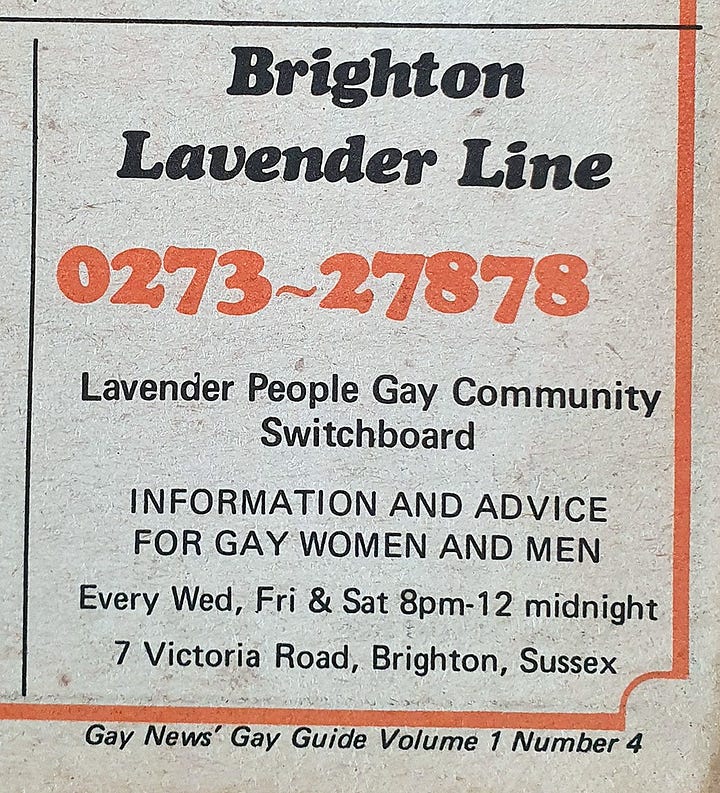
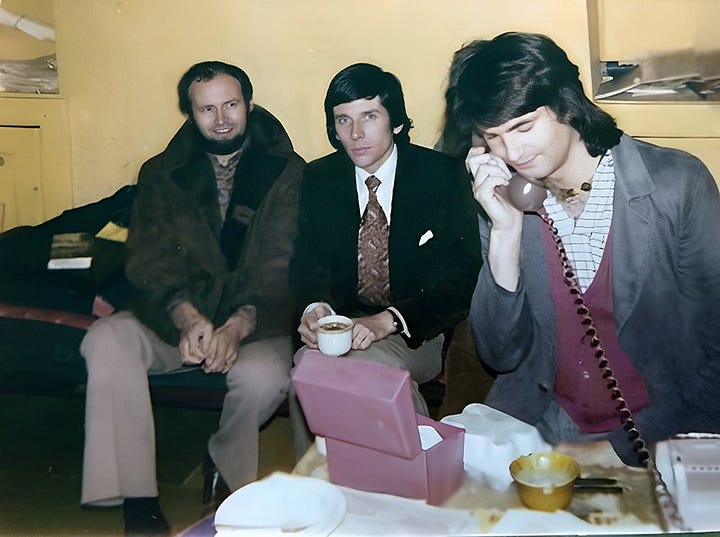
“When I got to Brighton in 1987 all there was was the Lesbian and Gay switchboard.”
In the pre-internet era, switchboards were the only information services young LGBTQ people who were new to an area could use to find gay spaces, such as a particular pub. They would dial a number, be put through to a landline that would be initially answered for two hours at the weekend.
The one in Brighton was set up by the aforementioned Sussex Gay Liberation Front in 1975 and was part of a gay information micro-culture that included bookshops, such as the Unicorn, and the London Gay Press that frequently had regional listings.
“The Press would only reference the established venues,” says Alf. “When you’re young these aren’t necessarily the ones you want to go to because they catered for an older market and played older music. It was armchairs and red-flock wallpaper.
“We wanted modern spaces - warehouses with loud, dance music. You’d get [details of] that at the switchboard.”
Alf says that once you made friends the switchboard wasn’t needed as you would hear about gay places opening up and social circles began mixing. But getting his straight friends to come to gay pubs or clubs was impossible with many asking ‘why would we want to go there?’
The appeal to gay people like Alf was obvious.
“LGBT pubs and clubs provide a space where you’re in the majority - which you just don’t get the rest of your life,” he says. “It’s kind of the same thing with race in the UK: it’s rare to be someone of colour, and be in the majority, unless you're in a particular space.”
But the opening up of wider spaces, such as pubs and taprooms, to LGBTQ people is something Alf feels bittersweet about because they differ greatly to the pubs and clubs we’ve talked about today. And some of the benefits he feels have been lost, although he admits it’s good that they’re not needed as much.
“The loss of gay spaces is very concerning to someone my age,” he concludes. “Because of what I went through in those spaces and because of how valuable and precious they were.
“You met your first partner there. They were first spaces you felt safe in and when you came out it was an important step in finding your community.”
Next week, Alf will be back discussing the battle that took place during the first Pride marches and how they helped fire change.

